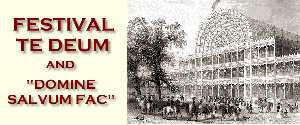You are here: > > > > Programme Notes
Programme Notes
by David Lyle
The Te Deum is in seven sections and opens with a fleeting reference to the well known hymn tune St. Anne, which re-appears in the final section in a blaze of colour, sung in unison by the whole choir. Throughout, the work owes much to Victorian Handelianism, with a number of tight-knit, skillful fugues, and displays Sullivan's use of keys, distant from the main C major tonality, to contrast the sacred and secular evocations of the text.
The second section, which introduces the soprano solo, changes the mood completely, with dark scoring (in the secular key of E flat) of organ, low brass and bassoons, which imparts a sombre flavour to the hushed chorus intonations of Holy, Holy, Holy. These alternate with exultant exclamations of Heav'n and earth are full of the Majesty of Thy Glory, the soprano voice soaring three times, to a top B flat, before the section ends in quietness.
The bustle and exuberance of the opening fugue are recalled in the third section (now back to the sacred key of G), with the chorus singing a harmonized version of a plainchant melody. This leads into another splendid fugue on the words Thou art the King of Glory. The section closes with the chorus intoning the fugue subject in slow, massive chords, over a typically Baroque walking bass.
In the fourth section, the solo soprano has a lyrical, operatic B minor melody, which she shares with the oboe, and which becomes a radiant B major in its final appearance, demanding a long-held top B from the singer, before its calm close.
The chorus which follows, after the affirmation, We believe that Thou will come to be our Judge, continues in this secular vein, in the same key of B major, with a lilting siciliano movement, on the words, We therefore pray Thee help Thy, servants.
The penultimate section returns to the sacred key of G, with a quiet prayer, O Lord save Thy people, which builds on a long crescendo before bursting out into a sturdy fugue, on the words Day by day we magnify Thee. This momentum is briefly interrupted when Sullivan sets the soprano solo’s words and melody, from the opening of the section, for full choir, in semibreves, over a restless, undulating quaver accompaniment. The fugue subject, this time in full chordal harmony, returns, triumphantly, to bring the section to a close.
The last section begins with the opening bars of the work s introduction, with the chorus sopranos now singing a complete version of St. Anne, with which Sullivan’s audience associated (and we still associate) the words, O God our help in ages past, and which, no doubt, heightened the feeling of Divine intervention in the Prince’s recovery. The music moves into a final, robust fugue, led by the basses, on the words, O Lord, let Thy mercy lighten upon us, interrupted, eventually, by the interjection of the military band, playing a totally unexpected, jaunty and completely un-religious march. This is repeated, with the men's voices now intoning St. Anne, allowing Sullivan to combine his sacred and secular worlds in spectacular fashion. The work closes, triumphantly, with God save the Queen and a final Amen, in a blaze of C major.
| | |
Page Created 24 June 2004
